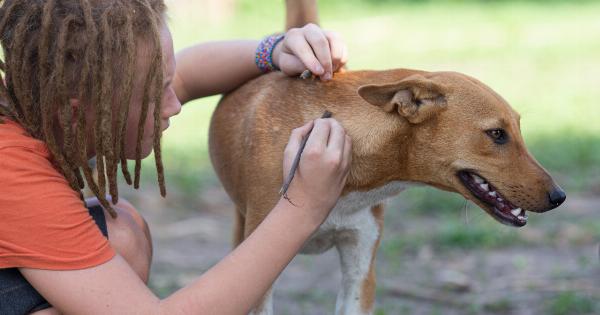Barking is a natural and instinctive behavior for dogs. It is their way of communicating and expressing themselves. However, there are occasions when excessive barking can become a nuisance to both owners and neighbors alike.
In some places, there are even fines imposed on dog owners for failing to control their pets’ barking. But does this mean that canines refrain from barking during moments of tranquility? In this article, we will delve into this question and explore the various factors that influence a dog’s barking habits.
Understanding Dog Barking
Before we assess whether dogs refrain from barking during moments of tranquility, it is important to understand why dogs bark in the first place. Barking serves several purposes for canines, including:.
- Communication: Dogs use barking to communicate with their owners, other dogs, or sometimes even with other animals.
- Alerting: Barking serves as a way for dogs to alert their owners of potential threats or intruders.
- Expression: Dogs may bark to express joy, excitement, fear, or discomfort.
- Attention-seeking: Some dogs resort to barking to get their owner’s attention or to fulfill their needs.
The Influence of Environment
The environment plays a significant role in a dog’s barking behavior. In tranquil settings, such as serene parks or quiet residential areas, dogs may be less inclined to bark.
This is because there are fewer external stimuli that trigger their alertness or urge to communicate. Dogs in these peaceful surroundings are more likely to engage in calm and quiet behaviors.
However, even in tranquil environments, there are exceptions. Certain breeds, such as those with guarding instincts or high energy levels, may still exhibit barking behaviors even during moments of tranquility.
For these breeds, it is crucial for owners to provide appropriate training and socialization to manage their barking tendencies effectively.
The Role of Training and Socialization
Proper training and socialization are vital in teaching dogs when and where it is acceptable to bark. Training should focus on teaching dogs to differentiate between necessary and unnecessary barking.
By introducing positive reinforcement techniques, owners can shape their dogs’ behavior and encourage them to remain calm during tranquil moments.
Socialization also plays a key role in a dog’s barking habits. Well-socialized dogs are exposed to different environments, people, and animals from a young age.
They learn to adapt to various situations and are less likely to bark excessively, even during moments of tranquility. Socialization helps dogs build confidence and reduces their need to rely on excessive barking as a response to new or unfamiliar situations.
Health and Emotional Factors
It is important to consider that dogs may bark excessively due to various health or emotional factors. These factors can influence their behavior regardless of the surrounding tranquility.
Some common health-related causes of excessive barking include pain, discomfort, anxiety, or underlying medical conditions. If a dog is experiencing any of these issues, it is crucial to consult a veterinarian for a proper diagnosis and treatment plan.
Similarly, emotional factors such as stress, fear, or separation anxiety can contribute to increased barking. Dogs who experience emotional distress may bark excessively, irrespective of the tranquility of their environment.
Identifying and addressing the underlying emotional causes is essential in managing a dog’s barking habits effectively.
Strategies for Managing Excessive Barking
If your dog tends to bark excessively, even during moments of tranquility, there are several strategies you can employ to curb this behavior:.
- Identify triggers: Pay attention to what triggers your dog’s barking and work on eliminating or minimizing these triggers.
- Positive reinforcement: Reward your dog for remaining calm and quiet during tranquil moments.
- Distraction techniques: Provide your dog with engaging toys or puzzles to distract them from barking.
- Training and obedience classes: Enroll your dog in training classes to teach them appropriate behavioral responses.
- Consult a professional: If excessive barking persists, seek guidance from a professional dog trainer or behaviorist.
Legal Implications and Fines
In certain jurisdictions, dog owners can face fines or legal consequences if they fail to address their pet’s excessive barking. These fines are often imposed to ensure that dogs do not become a nuisance to the community.
It is essential for dog owners to be aware of their local laws and take responsibility for managing their dog’s barking habits to avoid fines or legal complications.
The Importance of Responsible Ownership
Ultimately, responsible ownership plays a crucial role in managing a dog’s barking habits. It is the duty of every dog owner to ensure that their pet’s behavior does not infringe on the tranquility of their surroundings.
This involves providing proper training, socialization, and addressing any underlying health or emotional concerns that may contribute to excessive barking.
The Canine and Tranquility: Final Thoughts
While the propensity for dogs to refrain from barking during moments of tranquility may vary based on the individual dog, breed, and environment, responsible ownership and effective training can significantly reduce excessive barking.
It is essential to understand the underlying reasons behind a dog’s barking habits and address any issues promptly and appropriately. By doing so, both dog owners and their canine companions can enjoy peaceful moments of tranquility without the need to pay fines or face legal consequences.



























